Electricity market development process
-
(1) Non-Conventional Power Resources Participating Ancillary Services on Electricity
To achieve net-zero emissions, enhancing the flexibility and resilience of the power grid is the first priority. In 2019, the Taipower Company first introduced the “Non-Conventional Power Resources Participating Ancillary Services on Electricity”. This initiative allows for the provision of ancillary services by reducing loads or activating self-owned generation equipment. It successfully attracted over 84MW of private user resources, with an overall user execution rate in ancillary services stabilizing at around 106%. The services was ended in Dec 31st 2021.
-
(2) Automatic Frequency Control (AFC) of Energy Storage System
In collaboration with domestic enterprises and ESS manufacturers, TPC has initiated the “Asia's first” AFC project to procure 15MW of ESS resources providing frequency regulation services in July 2020. These ESS resources can automatically follow the frequency variation and can adjust its output/input within 1 second. The functionality of AFC on ESS resources has proved its value to prevent from the grid contingency during the blackout incident in 2021.
-
(3) Establishment of Energy Trading Center
Based on the success of the aforementioned plan, Taiwan government legislated regulations for energy trading and mandated Taipower Company to establish “Energy Trading Center” for ancillary service market and reserve capacity market. Currently, through the establishment of a qualified trading system by Taipower Company, in addition to the state-owned power generation industry, dozens of private companies have officially participated. Also, nearly thousands of individuals have passed the professional qualification examination for energy trading. Presently, 23 industries, including electronics, department stores and electric vehicle manufacturing, have contributed to stable power supply through the platform. Until February the end of February 2025, the registered capacity applications have reached over 1,939.8 MW or more.

Power Market Refinement from 2023 to 2024
-
(1) New Specifications
In July 2022, the energy trading platform introduced the E-dReg, allowing for the combined utilization of frequency regulation and energy transfer under the Regulation Reserve product. As of the end of February 2025, a total of 547.9 MW of resources have been successfully integrated into the grid , supporting Taiwan’s power system in smoothing and shifting net load variations caused by fluctuations in renewable energy. The 2025 energy storage deployment target of 1,000 MW—including 500 MW of dReg and 500 MW of E-dReg—has been successfully achieved.
-
(2) Marketing rules revision
After two years of market operation, Taipower Company revised the market rules for the energy trading platform on October 1, 2023, with the following key adjustments:
-
i. New product: E-dReg was renamed as the Energy-shifting with Dynamic Regulating Function Reserve, and it was separated from regulation reserve to become an independent trading product, strengthening its utilization in energy transfer. With this change, the energy trading platform now offers four trading products, as illustrated in Figure 1.

Figure 1. Ancillary service products
E-dReg during the period when there is no energy transfer schedule or no dispatch instruction, trading resource should maintain the operation function of automatic frequency control according to dynamic regulation technical specifications. When executing energy transfer schedule or dispatch instructions, trading resources should not only execute dynamic regulation capacity but also simultaneously execute the scheduled or instructed energy transfer amount.
-
ii. Revision of performance index calculation method: The calculation method is adjusted to review the performance index for the first three seconds every second and take the maximum value of these four seconds, then take the minimum value of the performance index per second for 3600 seconds in that hour. This is done to improve the identification of resource service indicators.
-
-
(3) System Optimization
In order to reduce the burden of qualified traders in maintaining the system and troubleshooting, and improve management efficiency and service quality, an SD-WAN platform was implemented in February 2023 for centralized management and maintenance. This network, featuring a star topology, improve transmission security and improve information security protection by preventing unauthorized IP access and prohibiting communication between qualified traders.

Received the Highest Honor from National Development Council
Taipower Company stood out among 145 agencies and won the 6th "Government Service Award-Digital Innovation Value-Added Award" of the National Development Council for the first time in 2023 for its energy trading platform. The energy trading platform uses digital information technology integration and an economic sharing energy trading business model to successfully attract private flexible power resources from 23 types of industries, including the electronics industry, department store industry, and electric vehicle industry, to join the dispatching ranks.
Taipower’s Electricity Trading Platform Wins 2024 Gartner Innovation Award for Asia-Pacific
The Taiwan Power Company (Taipower) has been awarded the 2024 Power and Utilities Innovation Award by the renowned U.S.-based research and advisory firm Gartner, securing the top honor in the Asia-Pacific region. Taipower’s “Electricity Trading Platform” was recognized for its adoption of a low-cost IT architecture that enhances grid resilience, while leveraging real-time dispatch of distributed energy resources and advanced digital technologies to improve market communication security and operational efficiency.
On April 3, 2024, when a magnitude 7.1 earthquake struck Taiwan, triggering the unexpected trip of eight generating units and resulting in a sudden loss of up to 3,200 MW, the platform demonstrated its exceptional capabilities. It enabled real-time dispatch, monitoring, and scheduling adjustments, thereby preventing load shedding and showcasing remarkable grid responsiveness.Looking ahead, Taipower plans to further integrate cutting-edge technologies such as digital twins, 5G, and artificial intelligence to continuously strengthen the flexibility and security of the power grid, supporting the nation’s energy transition and its commitment to achieving net-zero emissions.
Looking forward to the development of Taiwan's energy trading by the end of 2025, it is expected that more than 2,000MW of different types of power resources will be obtained through various emerging energy trading systems. These power resources with real-time dispatch and the energy trading technology capabilities established by Taipower will make Taiwan's power grid one of the most sustainable and resilient power systems in the world, and will make Taiwan more confident on the road to achieving net-zero emissions.
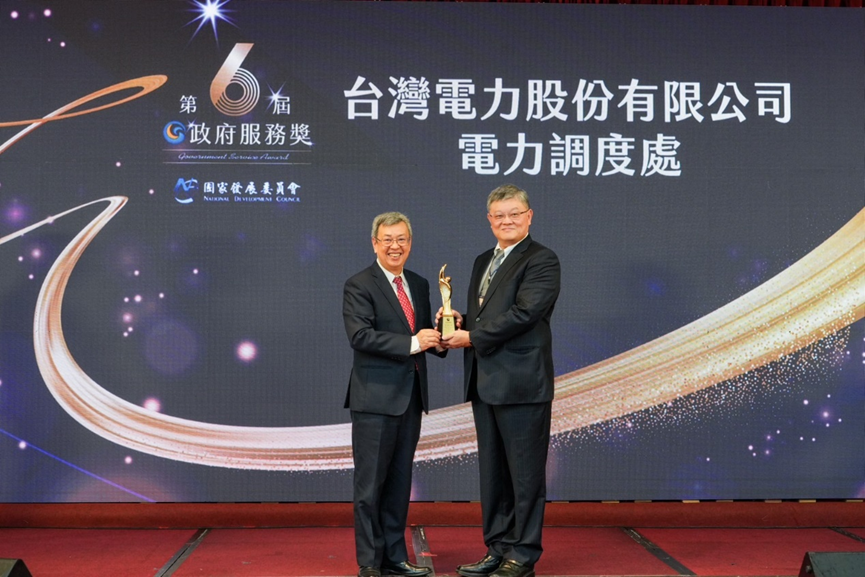

Related News
In order to increase the reliability of power supply and efficiency of power utilization, Taipower has accommodated customers with load management by adopting Demand Response Programs since 1979, with the first program of TOU Rate. The following programs have been implemented at present:
-
1. Time of Use Rate
-
2. Seasonal Rate
-
3. Preferential rate for Ice Storage Central Air-Conditioning System
-
4. Demand Response & Load Management Program
-
(1) Scheduled Load Reduction Program
-
(2) Emergency Load Reduction Program
-
(3) Demand Bidding Program
-
(4) Intelligent Load Reduction Program
-
The performance of demand response programs
In order to reduce the demand for power and the growth of peak load, Taipower has implemented demand response program to encourage customers to transfer the period of production process from peak load to off-peak load. In October 2024, which was the month with the most users joining “Demand Response & Load Management Programs (excluding Interruptible Air Conditioning Program)”, 4,071 customers applied and the amount of contracted reduction load was 3,006 MW. During the night peak day (July 22, 2024), the peak load was clipped by 1,314MW.
Related news
Grid Scale ESS
-
(1) Strategies and plans for the development of a battery energy storage system
As Taiwan moves towards its low-carbon and climate goals, it is actively developing green power and pursuing the installation of an energy storage system (ESS). Upon completion, the system will not only smooth green power generation, but also maintain frequency stability in the power system. In addition to those advantages, the system will increase the capacity value of renewable energy and improve power dispatching.
By 2025, Taiwan will have greatly increased its use of renewable energy. Consequently, TPC is working to add ancillary service capacity to its grid to accommodate the increased renewable energy connections. Moreover, TPC is preparing diverse responsive strategies for power dispatch, including the installation of combined cycle generators with quick ramp rates, changing pumping/storage operating modes, and adopting energy storage equipment.
TPC has achieved the target for 1000MW Battery Energy Storage System (BESS) by 2025, including 160MW of equipment at its own sites and 840MW of qualified participation capacity on TPC's Energy Trading Platform. BESS will help smooth the generation intermittency of renewable energy. Following any power system accidents, it will also be able to help withstand the failure of a large generating unit without causing the low-frequency relay action and tripping the user load. Energy-shifting with Dynamic Regulating Function Reserve also has an energy transfer function, which can help relieve pressure on the system caused by peak loads at night.
-
(2) The status of battery energy storage equipment installation
By the end of 2021, TPC has completed energy storage battery demonstration systems at two sites. These include a system on Kinmen with a total capacity of 3.8MW (11.8MWh) and a second system at the Shulin Branch of the Taiwan Power Research Institute with a total capacity of about 1.25MW (1.9MWh).
TPC has completed four grid scale energy storage battery systems in 2024, with a total capacity of 160MW.
In 2021, the Energy Trading Platform was stablished. Moving forward, TPC will obtain frequency regulation ancillary services from the Day-Ahead ancillary services market. The qualified participation capacity provided by BESS was 1458.6MW as of April 2025.
-
(3) TPC Own Grid Scale Site
In 2022, TPC has finished 20MW ESS in Tainan Salt Fields Solar PV site and 20MW ESS in Luyuan substation. In 2023, TPC has finished 60MW ESS in Longtan substation. In 2024, TPC has finished 60MW ESS in Dongshan substation.
Tainan Salt Fields, the first storage system with renewable energy in Taiwan, had won 2023 Asia Responsible Enterprise Awards in the category of Green Leadership. The storage systems have the advantage of fast charging and discharging, especially matching renewable energy characteristic, and helping solar PV generator electric output more smooth, also maintaining power system frequency and function of energy shift.
In addition to the ability to transfer energy and respond rapidly, TPC has further introduced Function of Periodic Power Modulation (FPPM) technology at the Dongshan energy storage system. By inputting test signals into the grid and obtaining real-time feedback data, Dongshan energy storage system provides valuable insights for power dispatching and system stability management.
Tainan Salt Fields Energy Storage System


Luyuan Substation Energy Storage System


Longtan Substation Energy Storage System


Dongshan Substation Energy Storage System


Regional Power Grid Battery Storage Project
From 2023 to 2025, TPC selected 8 secondary substations for Regional Power Grid Battery Storage Project demonstration sites, deploying a total of 20.5 MW of energy storage systems and 4 MW of diesel generators. These systems support both standard Grid Following Mode for normal operations and Grid Forming Mode for emergency situations, providing power for the entire feeder line, and having the ability to supply power to local areas. The setup enables local feeder power supply to maintain critical loads.
The actual power supply range depends on the energy storage system's real-time capacity and is managed in a segmented manner. This demonstrates the feasibility of supporting local power supply during transmission system blackouts, ensuring resilience in emergency scenarios.
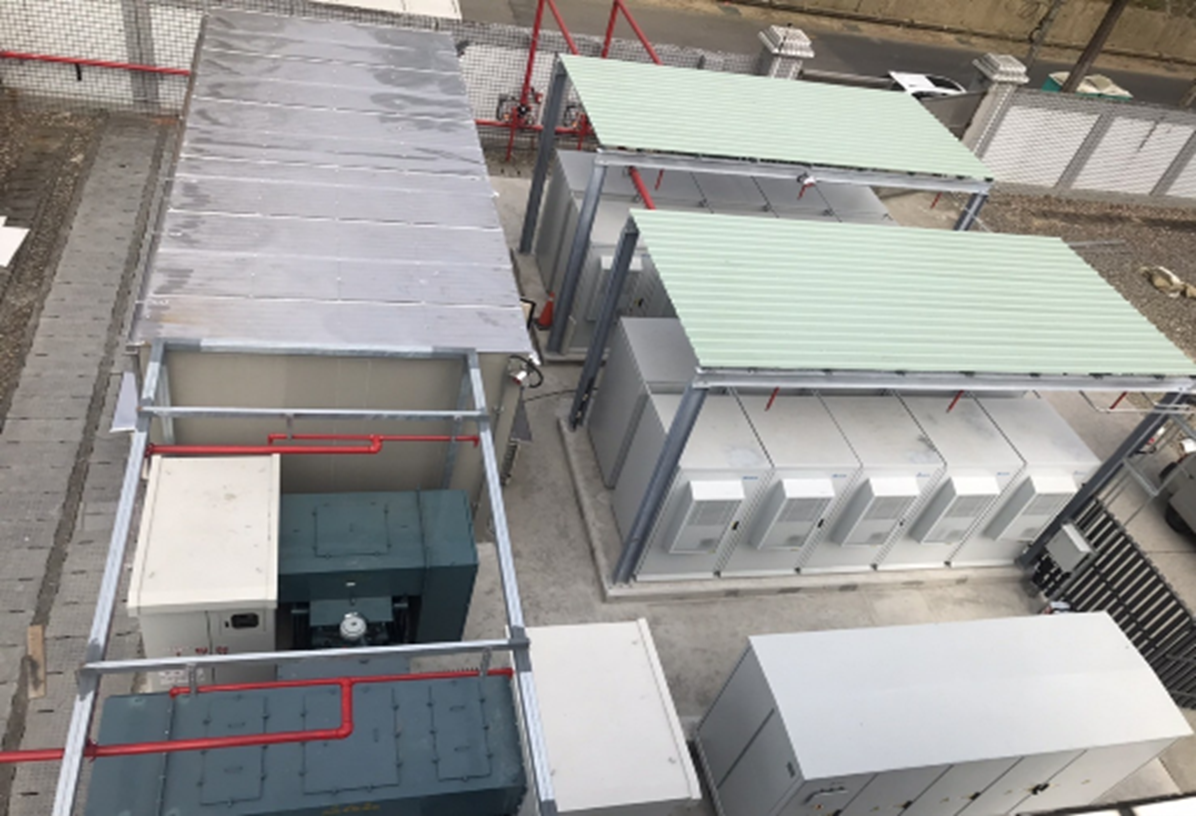
Regional Power Grid Battery Storage Project demonstration sites
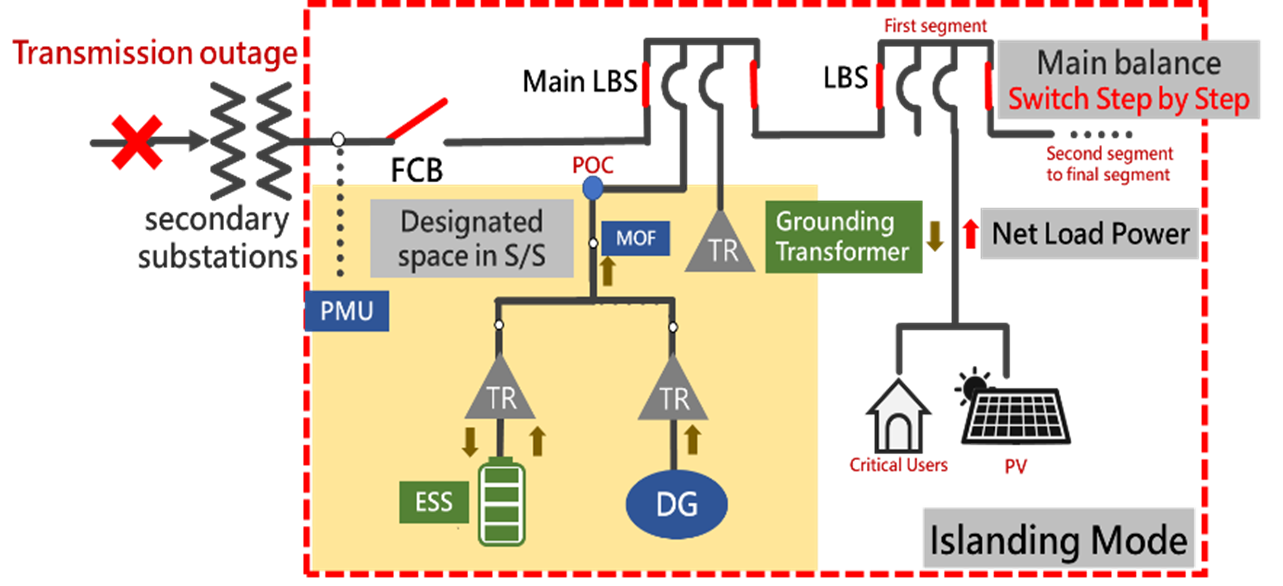
Schematic diagram of Islanding Mode
Kinmen Energy Storage System
Kinmen is an islanding power system. As renewable energy penetration increases, a possible way to make the power system more reliable is to install energy storage system (ESS). TPRI has already installed two sets of ESS in Xia-xing Power Plant, which not only assist power system operation but also enhance the knowledge and dispatch experience of ESS.
The power type of ESS uses Li battery(2MW/1MWh), which has already been constructed in December 2009. This system provides power system ancillary services and spinning reserve, carries out functions like renewable energy smoothing, frequency-watt control, voltage-var control and frequency deviation-P control. The energy type of ESS uses NaS battery(1.8MW/10.8MWh), which has already been constructed in December 2020. The main purposes are to execute load transformation, adjusting renewable energy generation period, and increasing diesel engine’s dispatch flexibility.

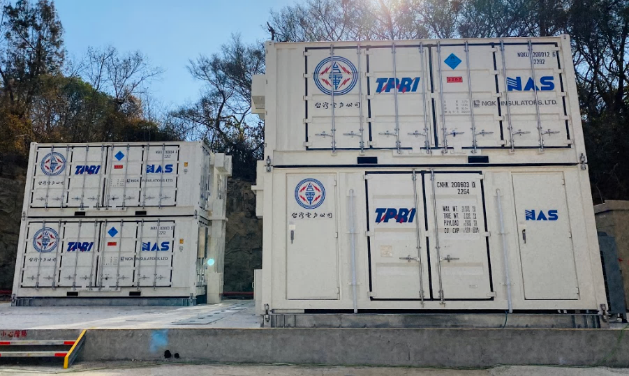
TPRI-EMS interface (left:homepage, left:peak shaving demonstration screen)
Green Energy Smart Management System of TPRI Sulin branch
The green energy smart management system installed in the Sulin branch of Taiwan Power Research Institute(tpri-EMS) was designed base on micro-grid concept. The tpri-EMS is consists of 9 energy management subsystems, including the photovoltaic storage test site. About battery energy storage systems, the performance test and verification of all-vanadium redox flow batteries and lithium-ion battery energy storage systems have been completed. In the future, the focus will be on the development of application functions of energy storage systems in microgrids, such as peak shaving, load tracking, automatic demand response, reduction of contract capacity, photovoltaic smoothing, implement of international information and communication standards and the verification of micro-grid transition function tests, including black start and seamless switching.
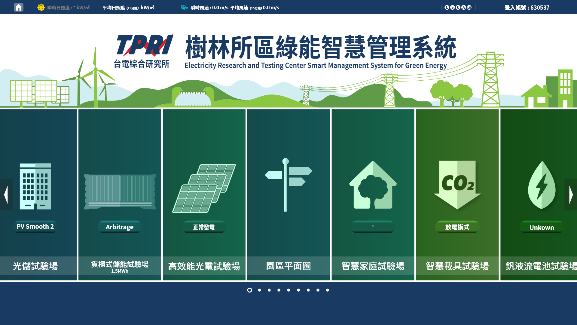
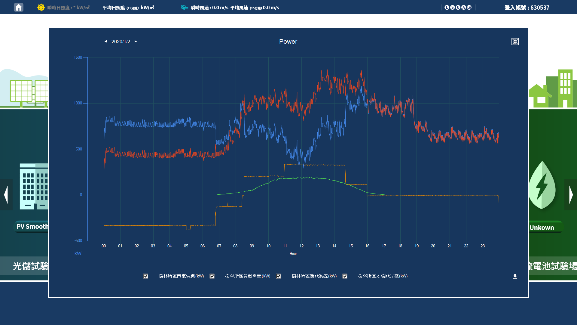
TPRI-EMS interface (left:homepage, left:peak shaving demonstration screen)
Evaluation of all-vanadium flow battery in renewable energy storage
In response to the intermittent of renewable energy power generation, energy storage technology is one of the effective solutions. Taiwan Power Research Institute (TPRI) has conducted energy storage demonstration experiments for smoothing renewable energy generation and controlling peak power demand. To successfully achieve these goals, TPRI has introduced an all vanadium redox flow battery’s energy storage system from Sumitomo Electric Industries Ltd. in May 2016. This 125kW/750kWh system was installed at Shulin branch of TPRI in 2017. Battery performance test, demand response, renewable energy smoothing, island mode operation, and cost minimization are tested in this system. In addition, long-term testing of the performance and durability of flow batteries are carried out. As technical comparison, a 250kW/400kWh and a 1.MW/1.5MWh container type lithium-ion battery energy storage system from local company has been constructed in this area since 2019.


Grid-connected energy storage system in Taipower Research Institute (left : vanadium redox flow battery, right : lithium-ion battery)
Demonstration and experimental study of a flywheel energy storage system for long duration applications
Flywheel Energy Storage System (FESS) stores energy by converting the electricity and the spinning kinetic energy with a bidirectional power conversion device. FESS is suitable for use cases that require hundreds of thousands cycles of charge & discharge. The power output ranges from kW to MW within a short period of 1 second
Mechanical energy of FESS is one of the conventional and stable energy storage mediums. The performance in terms of energy storage density, energy efficiency, power, and response time of the FESS is outstanding. Using mechanical energy for energy storage has advantages of long cycle life, reliable operation and zero impact to the environment. The energy efficiency of the FESS depends on manufacturing materials, electrical machines, types of bearing, and the vacuum chamber housing the rotor. The State of Charge (SOC) of the FESS can be directly calculated by monitoring the rotational speed of the flywheel which effectively improves the reliability of the power management system
In general, most FESSs can provide high power instantaneously with short duration. However, the FESSs providing the long charge and discharge duration for peak shaving and energy shifting is rare. Therefore, a FESS with rated power of 8kW, discharge duration of 4 hours, and 32 kWh energy has been installed by TPRI in TPC in 2019. The FESS is tested for various technical characteristics, and the reliability and corresponding performance of the specification have been demonstrated for the reference of application in the future.
After several earthquakes with magnitude 4 and magnitude 6 on the Richter scale, the flywheel system still works continuously. It also can be operated stably in summer without the use of air conditioning. The manpower and material costs required for operation and maintenance are extremely low, and only the vacuum pump needs to be maintained annually. The flywheel is expected to be worn out after long-term operation, and it only needs to replace the bearing for continuous running. It has great advantages in enduring application and provides reliable and stable backup power.


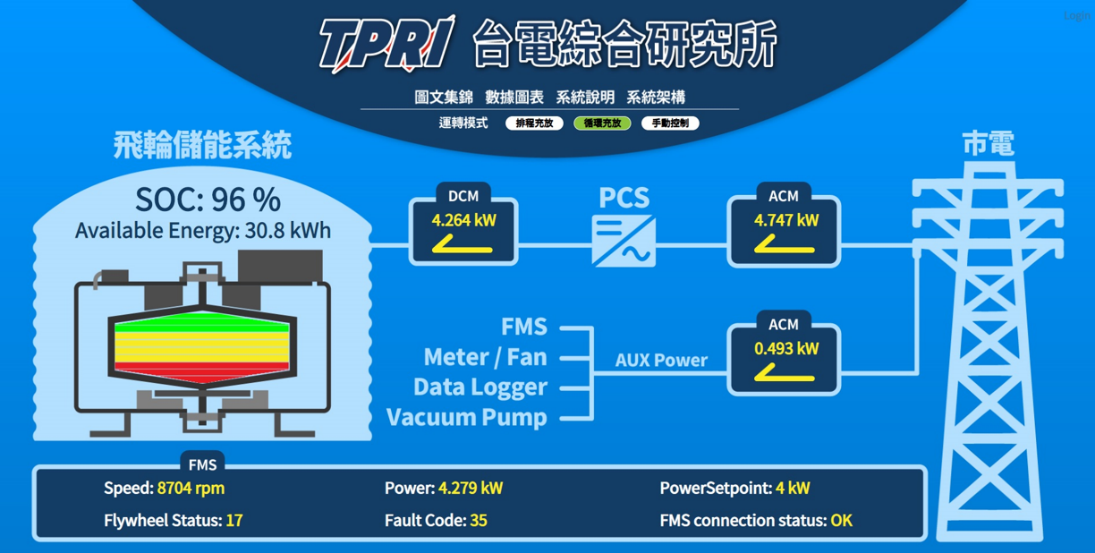
Related Regulations
To respond to domestic renewable energy development and energy management demand, energy storage equipment, installed by consumers, is a great tool which can be used with demand management and participate in ancillary service, is beneficial to improving power system stability.
To meet the demand of domestic energy storage equipment installation, TPC announced guidelines for grid connection of energy storage system on March 6, 2020.
Related news
- https://taipeitimes.com/News/biz/archives/2021/07/02/2003760143#:~:text=A%20new%20energy%20trading%20platform%20%28ETP%29%20designed%20to,capacity%20and%20electricity%20storage%20services%20came%20online%20yesterday
- https://www.energy-storage.news/powin-agrees-to-supply-5-8gwh-of-battery-storage-to-developers-for-projects-in-us-and-taiwan/
- https://www.energy-storage.news/powin-energy-supplies-battery-storage-for-microgrid-in-israel-frequency-regulation-in-taiwan/
- https://www.energy-storage.news/roundup-fluences-first-taiwan-project-redflows-2mwh-california-flow-battery-stem-inc-acquires-alsoenergy/
- https://www.eetasia.com/bureau-veritas-executes-iec-62933-testing-and-certification-for-taiwan-powers-60mw-on-site-energy-storage-system/
- https://renewablesnow.com/news/fluence-teco-to-add-60-mw96-mwh-of-battery-storage-for-taiwans-taipower-782318/
- https://www.energy-storage.news/taiwan-cement-corporation-adds-to-420mwh-bess-order-from-subsidiary-nhoa/
- https://www.digitimes.com/news/a20221221PD209/energy-storage-system-tatung-forever-energy.html
- https://www.altenergymag.com/article/2022/06/2022-top-article-sma-storage-solution-turns-the-lights-back-on-in-taiwan/37369
- https://www.smart-energy.com/regional-news/asia/enel-x-deploys-world-first-battery-swapping-vpp-in-taiwan/
- https://www.energy-storage.news/nhoa-parent-company-tcc-raising-funds-for-energy-storage-players-10x-growth-masterplan/
- https://www.energy-storage.news/fluence-supplied-60mw-80mwh-taiwan-bess-starts-operations/
- https://www.energy-storage.news/nhoas-new-311mwh-bess-in-taiwan-designed-specifically-for-new-e-dreg-ancillary-service/
- https://www.energy-storage.news/billion-watts-technologies-completes-262mwh-frequency-response-market-bess-in-taiwan/
Distributed Renewable Energy Advanced Management System (DREAMS)
-
(1) DREAMS with Smart Inverter
In response to the policy of energy transition in our country, a huge amount of renewable energy will be connected to the power distribution system in the future. In order to solve the problem of the maximum grid hosting capability of power distribution system limited by strength of power grid and intermittent power generation characteristic of renewable energy system, the “Distribution Renewable Energy Advanced Management System (DREAMS, shown in Figure)” can be used in coordination with smart inverter to adjust the power factor of renewable energy system to absorb the reactive power in order to maintain the voltage quality. In addition to the effective management of the impact of renewable energy on the power distribution system, the simulation analysis of power distribution feeder can verify that, under the same voltage variation constraint, the incorporation of DREAMS in conjunction with the self-adjustment function of smart inverter can enhance the permissible hosting capacity of renewable energy system of the feeder by more than 20%.
Figure . Distribution Renewable Energy Advanced Management System (DREAMS)

-
(2) DREAMS Planning and Construction Schedule
-
A. The power generation information of the sites with renewable energy system installation of more than 500kW will be collected according to TPC DNP3.0 communication protocol. The information shall include power generation volume of active and reactive power, power factor, voltage at Point of Common Coupling (PCC), and relevant setting values. The aforementioned information should be sent back to DREAMS via 4G communication system.
-
B. In the medium-term, in response to the diversification of distributed energy resources, DREAMS management functions will be expanded. In the future, it will collect real-time power information from distribution-level photovoltaic energy storage systems, electric vehicle charging pile management systems, and microgrid systems to provide timely dispatching reference for the dispatch center and also have load Integration and demand control functions.
-
C. In long-term, DREAMS is expected to be interfaced with “Advanced Distribution Management System (ADMS)” to execute remote monitoring of renewable energy site via transmission of control command to the smart inverter of renewable energy in order to enhance the grid resilience and to maintain good power supply quality based on maximization of renewable energy.
-
-
(3) DREAMS Planning in Future
The future plan is to adopt DREAMS in coordination with ADMS, so the network topology architecture can be updated in real time according to the switching operation decision of dispatch of power distribution system. And the system impact analysis can be conducted based on the power generation information of renewable energy collected by the renewable energy management system in order to derive the control decision of renewable energy smart inverter. In the end the control station and download the aforementioned control decision to the smart inverter via 4G communication system to achieve the modulation of renewable energy system power output in order to provide the auxiliary service function required by maintaining the safe operation of power grid.
Green Energy Estimate and Monitor System (GEMS)
Taiwan has a maritime island climate, characterized by distinct seasons and frequent afternoon thunderstorms. These weather patterns significantly impact solar photovoltaic (PV) power generation. To quickly detect deviations between actual PV power output and predicted values, visualizations are essential. Additionally, integrating wind and solar power data into a single visualization page provides dispatchers with a comprehensive reference.
Therefore, on the existing Green Energy Estimate Monitor System (GEMS),a solar photovoltaic standard deviation feature has been developed by applying data value-added techniques. It incorporates the concept of standard deviation mathematical models and utilizes historical and current solar photovoltaic generation data. The system calculates the average hourly power generation and the hourly variation in power generation (as indicated by the gray and black dashed lines in the diagram). It then presents the variation by adding or subtracting 1.64 times the standard deviation to create upper and lower trajectories (shown as light green dashed lines). Additionally, the standard deviation of historical hourly power generation variations (represented by the light blue area) is displayed as the range interval. The ramp of power generation every half hour on the monitoring day (that day) is normalized (multiplied by 2) to hourly, and the current situation is displayed quickly through real-time display (green bar).
Analyzing the standard deviation of each period through historical data of different days, the results suggested that 60 days is better. Calculated based on the changes in photovoltaic power generation for each hour in the past 60 days, there is a 90% chance that photovoltaic ramp of power generation for each hour of the day within the upper and lower trajectory of the standard deviation. It can be used as a reference for preparing Fast Responsive Reserve units to prepare Fast Responsive Reserve Units in advance to cope with the impact of photovoltaic power generation by seasonal changes.

Figure 5.1 Green Energy Estimate Monitor System (GEMS)
Related News
Background information
In recent years, with the government expanding its efforts to promote the green energy development policy, related renewable energies such as photovoltaics, wind power, hydroelectricity and geothermal power, all of which are Distributed Energy Resources (DER), will be massively grid-connected to the distribution system, and it will significantly change the entire distribution network structure. The electric power will no longer be generated by the generator units in large power plants, but rather be generated by small and decentralized devices. In order to fully understand the grid-connection status of the renewable energies, Taipower began to develop the Distribution Planning Information System (DPIS) since years ago, attempting to regulate the possible impact to the system when those energies are grid-connected by adopting the application review mechanism for Distributed Energy Resources.
According to records, there are nearly 10,000 feeders in the power distribution lines in Taiwan. The amount of data is huge and its number in the hosting capacity sections is as high as 3.26 million. When presented on a traditional web-based graphics platform, it would consume a considerable amount of software and hardware resources and may result in performance problems caused by a large amount of map data loading. Therefore, the Map Tile display technology will be used to generate the map tile files after the incorporation of timed calculations of each hosting capacity section, and then combined with the TGOS Address Geocoding Service and the generic version of the electronic maps to construct the visualized distribution feeder hosting capacity system. The system provides the public or the industry to conduct a location query by means of an address to achieve the purpose of visualizing the distribution feeder hosting capacity
System architecture description
The system is divided into two parts: the internal system and the external system. The architecture picture are shown in Fig1.
In order to allow external users to have a more intuitive understanding on the possible hosting capacity of feeder line, this project will regularly extract the topology information of existing distribution equipment from each business branch of Taipower by using the Extract-Transform-Load (ETL) technology. This project then simplifies it to become the information structure required to calculate the possible hosting capacity and subsequently summarize and send it to the information center as the basic information for computation.
We tested several computing cores and compared their benefits. Analyze its accuracy and calculation speed, and choose the best one.
Calculation results will integrate to the Geographic Information System (GIS) technology and displaying the possible hosting capacity of each feed line section on the map with colors.
Furthermore, to solve the performance issue that may be caused by external users downloading a large number of map data, this project constructs a feeder hosting capacity visualization system by using Map Tile display technology. It was thereby achieving the establishing hosting capacity visualization of the feeder.

Fig 1. The architecture of Feeder Hosting capacity visualization system
Power system impact analysis
This system integrates data from several systems automatically, such as Distribution Mapping Management System, Renewable Integrated System, Distribution Planning Information Systems, etc. Input data mainly include wire parameters, transformer parameters, electrical connectivity, power distribution equipment data, transformer data, load data, renewable energy data, user data, coordinate points, etc. Comprehensively organize all the materials and build a complete feeder input file. The schematic diagram of power system impact analysis is shown in Fig.2.

Fig 2. Schematic diagram of power system impact analysis
Taipower has about 10,000 total feeders, and the number of calculations for each joint is very large. Considering the overall load of the mainframe and the accuracy of the data, the core of the most cost-saving calculation is adopted. Each joint will be inversely calculated one by one, and get the maximum hosting capacity finally. It will be the basis of updating the externally displayable hosting capacity.
System introduction
In order to allow the user to clearly view the hosting capacity of each section of feeder, we indicate the hosting capacity of each section by means of color display. This referred to the webpages which are built by the foreign electricity utility. The hosting capacity is divided into six levels and six colors from small to large, and display on the geographic map.
-
Feeder hosting capacity visualization system for power distribution system:https://service.taipower.com.tw/hcweb/geohc/

Fig3. System introduction page

Fig4. Side information bar
Fig5. System description and notices
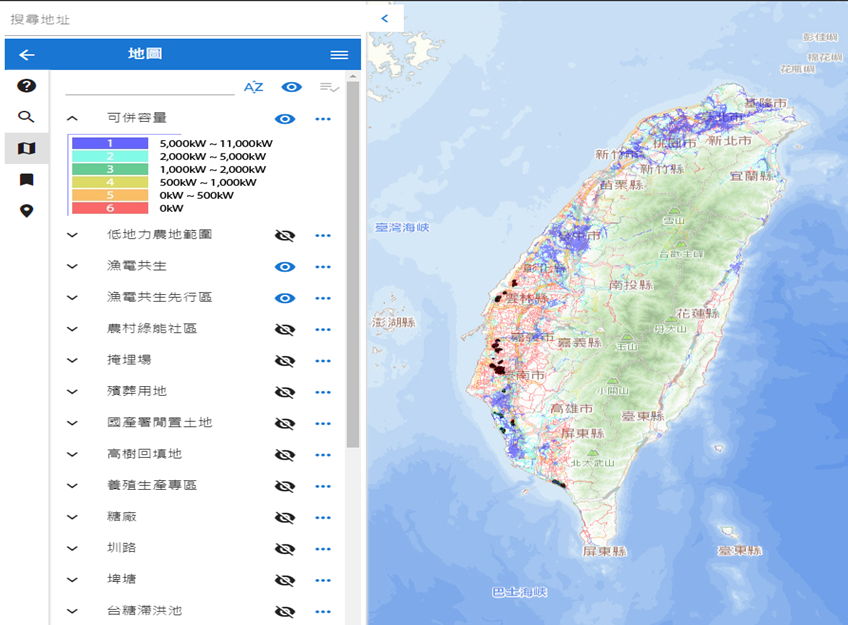
Fig6. System description and notices
Fig7.Legend and layer switch
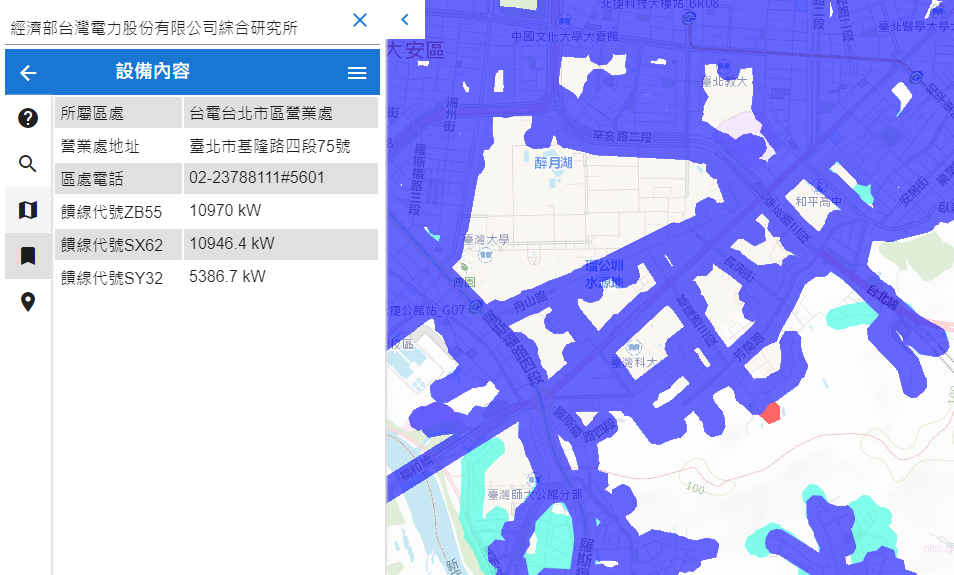
Fig8. Feeder information
Background
In Taiwan, the Electricity Act is passed in January 2017. This act has activated the reform of electricity liberalization. To alleviate the impact of the reform on the current system, the first stage will be the so-called “renewable energy first,” which means that free trading of green energy is permitted and consumers are allowed to choose their power suppliers. Trying to learn from other countries’ experiences and see if they can fit well with our industrial structure, TPC is now working on the formulation of regulations for power wheeling and grid-connection type direct supply, and also establishing the “power wheeling & direct supply platform” on which relevant works can be done.
Project contents
The structure of power wheeling and grid connection type direct supply is shown in figure 1. Power wheeling means that power source can transmit power to customers through grid company; grid connection type direct supply means that customers are connected to power sources through private lines. Renewable energy, Due to their intermittent property, are still considered as unstable power source. Therefore, when there is surplus or lack of power, TPC, as an electricity retailing utility enterprise, is responsible of maintaining stable power supply.

Figure 1 Illustration of power wheeling and grid connection type direct supply
The purpose of “power wheeling & direct supply platform” is to promote the service of power wheeling and direct supply. Figure 2 shows the structure of the platform. With the help of AMI, which precisely records power generation and consumption every 5 minutes, the amount of power, either delivered through power wheeling or direct supply, can be analyzed and used as the basis of reviewing of “bundled renewable energy certificate.”

Figure 2 Structure of power wheeling & direct supply platform
Necessity of the project
-
(I) Providing compound ways of selling power
In the past, power generated by renewable-energy-based electricity generating enterprise are sold to TPC at price of the feed-in tariff announced by the government. Now, the power wheeling & direct supply system can provide renewable energy developers with compound choices of how they are going to sell their power, as shown in figure 3.

Figure 3 Electricity market in Taiwan
-
(II) Satisfying needs of industries
Many corporations had already announced that they will use green energy as their power source. Also, the government also legislate that the percentage of green energy usage should reach specific degrees. The power wheeling & direct supply system can help corporations not only satisfy the regulations set by the government but also acquire the bundled renewable energy certificate.
-
(III) Set the foundation for overall electricity liberalization
Electricity liberalization is a trend of electricity development. Through completion of relevant regulations and operating scheme, step by step, during the process of promoting electricity liberalization, this project will help set a foundation for overall electricity liberalization.
-
(IV) Transaction management via implementing the platform
The “power wheeling & direct supply platform” possesses several intact functions such as wheeling contract management, power consumption settlement, cost accounting, etc. Also, the platform is able to integrate with power acquisition mechanism and public electricity retailing mechanism. In the future, in face of overall electricity liberalization, this platform can be expanded as a mid- and long-term electricity transaction management platform.
Benefits of the project
-
(I) Benefits for TPC
It is believed that the promotion of power wheeling & direct supply system can help TPC adjust its organization and nurture relevant employees to make sure that overall electricity liberalization is successful in the future.
-
(II) Benefits for customers
The power wheeling & direct supply system can offer customers compound ways of purchasing electricity. Through marketing mechanism, customers are free to choose their own power supplier to satisfy their needs of green energy purchases. and acquire the bundled renewable energy certificate. Also, combination of different retailing schemes can help corporations reduce their cost on power consumption
-
(III) Benefits for industries
Through marketing mechanism, corporations can be more competitive and efficient in their performances. In addition, more corporations can be attracted to invest in the development of renewable energy technologies.
-
(IV) Promoting construction of smart grid
Customers who participate in the platform of power wheeling and direct supply are required to install AMI smart meters. It is helpful for increasing the penetration of AMI and speeding up construction of smart grid.
-
(V) Speeding up renewable energy development to meet the government goal
To achieve the goal 2050 net zero emissions in Taiwan. Besides elevating capacity of renewable energy. Also through promotion of mechanism of power wheeling & direct supply to establish a market that is equitable and sound, more corporations can be encouraged to participate in the green energy industry. Thus, the goal of energy transition can be achieved.
Conclusion
Electricity liberalization has become a global trend. In Taiwan, regulations, techniques, industrial environment, and social consensus are all mature and ready for electricity liberalization. The mechanism of power wheeling and direct supply will kick-start the electricity liberalization in Taiwan. Also, the power wheeling & direct supply platform is beneficial for execution of power wheeling and direct supply contract. It is expected that through sound planning we will be able to reach the goal of electricity liberalization.
